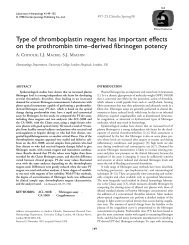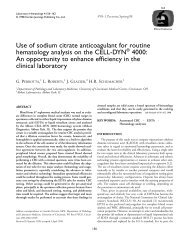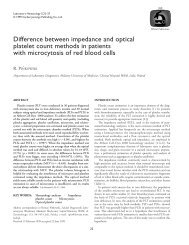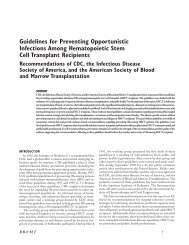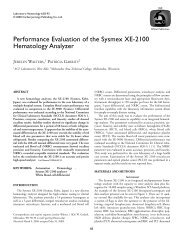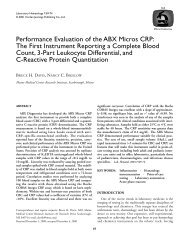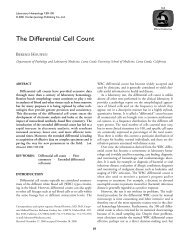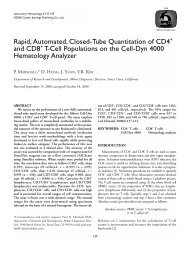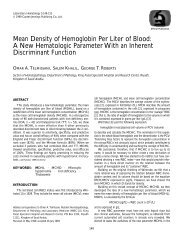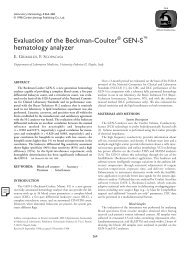Mean density of hemoglobin per liter of blood - Carden Jennings ...
Mean density of hemoglobin per liter of blood - Carden Jennings ...
Mean density of hemoglobin per liter of blood - Carden Jennings ...
Create successful ePaper yourself
Turn your PDF publications into a flip-book with our unique Google optimized e-Paper software.
4 OA Telmissani et al.<br />
MDHL in a normal reference population, whereas patients with<br />
TT have an MDHL higher than the mean. For discrimination<br />
between IDA and TT, we evaluated MDHL for sensitivity, specificity,<br />
predictive value, and efficacy, compared with the previously<br />
reported formulas (Fig.1). As shown in Table 3, sensitivity, specificity,<br />
predictive value, and efficacy were su<strong>per</strong>ior to those obtained<br />
with the other formulas. Seven female patients who had IDA and<br />
were under specific therapy were correctly classified by a low<br />
MDHL. What is extraordinary about MDHL is that when we<br />
exclude 3 patients (2 women and 1 man) who had combined IDA<br />
and β-TT (IDA prevailing in 2 patients and TT in the other<br />
patient), the sensitivities, specificities (negative and a positive PV)<br />
reached 100%. This discriminating ability holds whether β-TT or<br />
α-TT is considered.<br />
An intriguing observation is that, although the mean MDHL<br />
provided a clear discriminator between IDA and TT, 50% <strong>of</strong> the<br />
healthy subjects must, by definition, have a lower MDHL, whereas<br />
the other 50% must have a higher MDHL. Thus, MDHL is <strong>of</strong><br />
no apparent value in subjects with normal MCV and MCH. But,<br />
when appropriately applied, MDHL provides an extremely powerful<br />
screening tool for discriminating between IDA and TT. Programming<br />
new or even present-generation counters would be a<br />
relatively simple matter that could result in considerable savings in<br />
the general practice <strong>of</strong> hematology.<br />
ACKNOWLEDGMENTS<br />
We wish to thank the technical staff <strong>of</strong> the Section <strong>of</strong> Hematology,<br />
Department <strong>of</strong> Pathology and Laboratory Medicine,<br />
KFSH&RC, for their unstinting help during this project. Special<br />
thanks to Dr. Samir Ballas for his advice on the preparation <strong>of</strong> the<br />
manuscript.<br />
REFERENCES<br />
1. WINTROBE MM. A simple and accurate hematocrit. J Lab Clin Med.<br />
1929;15:287.<br />
2. WINTROBE MM. Wintrobe’s Clinical Hematology. 8th ed. London: 1981:8.<br />
3. WINTROBE MM. Wintrobe’s Clinical Hematology. 8th ed. London:<br />
1981:18.<br />
4. ENGLAND JM, FRASER PM. Differentiation <strong>of</strong> iron deficiency from thalassaemia<br />
trait by routine <strong>blood</strong>-count. Lancet. 1973;1:449-452.<br />
5. ENGLAND JM, FRASER PM. Discrimination between iron-deficiency and<br />
heterozygous-thalassemia syndromes in differential diagnosis <strong>of</strong> microcytosis.<br />
Lancet. 1979;1:145-148.<br />
6. MENTZER WC. Differentiation <strong>of</strong> iron deficiency from thalassaemia trait.<br />
Lancet. 1973;1:882.<br />
7. SHINE I, LAL S. Strategy to detect beta-thalassemia minor. Lancet.<br />
1977;1:692-694.<br />
8. FAIRBANKS VF, HINES JD, MAZZA JJ, HOCKING WG. The anemia. In:<br />
Joseph J. Mazza, ed. Manual <strong>of</strong> Clinical Hematology. Boston: Little Brown<br />
& Co Inc; 1995:17.<br />
9. AL-BUHAIRAN A. Base-line hematological parameters in healthy adult male<br />
and female Saudis. Master’s Degree Thesis. King Saud University, Riyadh,<br />
1998.<br />
10. AEMBROUSKI GS, SULLIVAN AM. Quality control and statistics. In: Bishop<br />
ML, Duben JL, Fody EP, eds. Clinical Chemistry: Principles, Procedure,<br />
Correlation. 1985:68.<br />
11. MOHANDAS N, KIM YR, TYCKO DH, ORLIK J, WYATT J, GRONER W.<br />
Accurate and independent measurement <strong>of</strong> volume and <strong>hemoglobin</strong> concentration<br />
<strong>of</strong> individual red cell by laser light scattering. Blood.<br />
1986;68:506-513.<br />
12. MOHANDAS N, JOHNSON A, WYATT J, ET AL. Automated quantitation <strong>of</strong><br />
cell <strong>density</strong> distribution and hy<strong>per</strong>dense cell fraction in RBC disorders.<br />
Blood. 1989;74:442-447.




